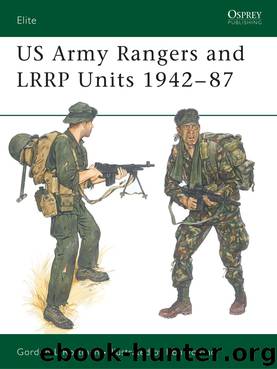US Army Rangers & LRRP Units 1942-87 by Gordon Rottman

Author:Gordon Rottman
Language: eng
Format: epub
Tags: US Army Rangers and LRRP Units 1942–87
ISBN: 9781782004486
Publisher: Osprey Publishing
Student Recon. Team members of the MACV Recondo School off-load from a UH-1H ‘Huey’ during their three-day graduation patrol on Hon Tra Island, Bay of Nha Trang, Dec. 1969. They are armed with M16A1 and AK-47 rifles. (US Army)
In order to train LRP unit members, the 5th SF Gp. established the Military Assistance Command, Vietnam Recondo School at Na Trang on 15 Sept. 19661. The three-week course taught US and allied troops Vietnam-oriented LRRP techniques. The Infantry School conducted a six-week LRP Course at Ft. Benning as well. Few LRP/Ranger unit members were actually graduates of the Ranger Course; most of the troops were volunteers from within the unit’s parent division/brigade. While the units were considered airborne, in actuality many of the personnel were non-jumpers.
In the US, D-17 and C-58 were redesinated A-and B-75 in 1969. A-75 was placed under Third Army and attached to the 197th Inf. Bde. and B-75 was assigned to Fifth Army (Sixth Army in 1972). Both were still slated for Germany. A year later A-75 was relocated to Ft. Hood, Texas, assigned to Fourth Army, attached to III Corps, and later to the 1st Cav. Division. In June 1973, B-75 was relocated to Ft. Lewis, Washington. Additional ARNG companies were formed: E-200 in Alabama in 1969, and E-65 in Puerto Rico and A-259 in Delaware, both in 1971. Indiana’s E-151 was inactivated in March 1971 when it consolidated with D-151. The same took place in Michigan when E-425 was consolidated with F-425 in Feb. 1972.
The Vietnam Ranger companies were inactivated between 1969 and 1972 when the units they were attached to were inactivated in-country or returned to the US. The 75th Inf. Cos. were awarded four Valorous Unit Awards, one Meritorious Unit Commendation, 15 Vietnamese Gallantry Cross Unit Citations, and nine Vietnamese Civil Actions Unit Citations. O-75 was reactivated in 1970 at Ft. Richerson, Alaska; assigned to US Army, Alaska, the ‘Arctic Rangers’ provided aggressor support, and were to conduct search-and-rescue operations for downed airliners flying the polar route.
About 2,000 Ranger-qualified officers and NCOs served as advisers to the Army of the Republic of Vietnam’s Ranger (Biet Dong Quan—BDQ) units. Growing from 86 companies in 1960, consolidated into battalions in 1965, a total of eight BDQ groups (regimental-sized), with 22 BDQ battalions, existed by the US withdrawal in 1972. The BDQ were, in reality, light infantry units intended for special employment, although only a few were airborne.
SF Operational Detachment A-41 (Ranger) of the 46th SF Co. was the only SF unit to additionally be designated Ranger. It was responsible for instructing the Royal Thai Army Ranger School at Lopburi. All of the team’s personnel were Ranger-qualified; many of the NCOs had been instructors in the US Army Ranger Department. Co. B (Airborne/Ranger), 1st Bn., 29th Inf., attached to the Infantry School, was used to test airborne tactics and infantry equipment, and to act as aggressors for the Ranger Department in the early and mid-1970s.
Download
This site does not store any files on its server. We only index and link to content provided by other sites. Please contact the content providers to delete copyright contents if any and email us, we'll remove relevant links or contents immediately.
Whiskies Galore by Ian Buxton(41879)
Introduction to Aircraft Design (Cambridge Aerospace Series) by John P. Fielding(33064)
Small Unmanned Fixed-wing Aircraft Design by Andrew J. Keane Andras Sobester James P. Scanlan & András Sóbester & James P. Scanlan(32743)
Craft Beer for the Homebrewer by Michael Agnew(18140)
Turbulence by E. J. Noyes(7936)
The Complete Stick Figure Physics Tutorials by Allen Sarah(7307)
Kaplan MCAT General Chemistry Review by Kaplan(6867)
The Thirst by Nesbo Jo(6826)
Bad Blood by John Carreyrou(6552)
Modelling of Convective Heat and Mass Transfer in Rotating Flows by Igor V. Shevchuk(6391)
Learning SQL by Alan Beaulieu(6209)
Weapons of Math Destruction by Cathy O'Neil(6143)
Man-made Catastrophes and Risk Information Concealment by Dmitry Chernov & Didier Sornette(5921)
Digital Minimalism by Cal Newport;(5664)
Life 3.0: Being Human in the Age of Artificial Intelligence by Tegmark Max(5474)
iGen by Jean M. Twenge(5366)
Secrets of Antigravity Propulsion: Tesla, UFOs, and Classified Aerospace Technology by Ph.D. Paul A. Laviolette(5309)
Design of Trajectory Optimization Approach for Space Maneuver Vehicle Skip Entry Problems by Runqi Chai & Al Savvaris & Antonios Tsourdos & Senchun Chai(5011)
Pale Blue Dot by Carl Sagan(4912)
